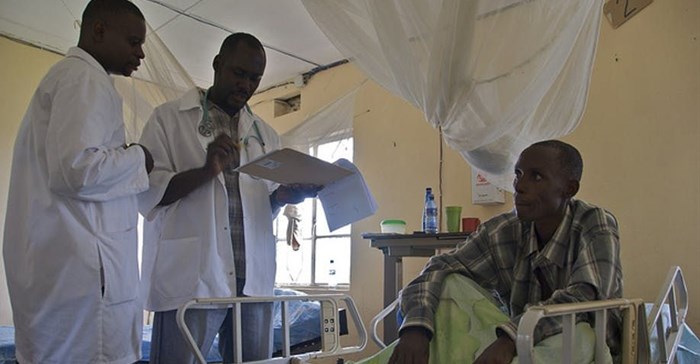
Health systems rarely consider that patients switch between hospitals or primary healthcare centres and indigenous medicine for their health issues. Direct Relief/Tobin Greensweig
This is why revamping the systems that provide health care in post-conflict settings is a top priority for the international aid community and governments.
Such revamps are usually conceptualised using the World Health Organisation’s six building blocks. These centre on leadership and governance; healthcare financing; health workforce; medical products and technologies; information and research; and service delivery. The way in which the building blocks are applied, and what’s prioritised, tends to happen on a case by case basis.
But there’s often something missing from the process: an understanding of the different forms of indigenous healthcare or traditional medicine.
The use of indigenous medicine is widespread globally. It often co-exists with the use of biomedicine. The World Health Organisation estimates that, for instance, around 80% of Africa’s total population uses indigenous medicine.
In a recent study, we looked at Burundi to see what could be learnt from the interaction between indigenous health practitioners and public health systems in post-conflict zones.
Our study challenged the myth that people who used traditional medicine were poorer or less educated than those who used biomedicine. It showed that while there was still resistance from some doctors and nurses, there were instances when healers and medical practitioners referred patients to each other.
And crucially, it highlighted how helpful these interactions could be in countries where the health systems have limited capacity.
Between two systems
Burundi’s health system has some of the typical difficulties of a post-conflict health system: the infrastructure has improved but the human resources, drug supplies, and research remain challenges that the country faces as it recovers from the after-effects of a brutal civil war. Nevertheless, the country has a legal framework for traditional healers.
In our study, we combined a survey which included more than 6,500 households with interviews carried out among healthcare practitioners in the southern part of the country in Gihofi district.
Our study found two things. Firstly, it reinforced previous research that shows that patients switch between hospitals or primary healthcare centres and healers for their health issues.
They seek cures for some of their ailments in hospitals or primary healthcare centres. But when those do not work, or for other health issues – and particularly those conditions that they see as being of psychosocial or spiritual nature – they prefer to see an indigenous medicine practitioner. This is because indigenous medicine often incorporates psycho-social and spiritual dimensions in both the diagnosis and the treatment.
But secondly, we found that doctors and nurses’ attitudes were often ambivalent. Many outright rejected any non-biomedical approach to healthcare practice. But there were instances of cross-referrals between health centres and healers.
Given this, we suggest that it may be easiest to establish regulated cross-referrals between biomedical staff and herbalists, (who tend to be more accepted than other healers), for conditions known to be treatable by certain herbal preparations.
The interactions brought various ethical issues to the fore. This included the healers’ willingness and ability to diagnose and refer patients to health centres when their conditions needed prompt biomedical intervention. A case in point is severe malaria.
In addition, there was also the problem that patients often hide or misreport the fact that they used indigenous medicine because they feared doctors and nurses would disapprove. This carries the risk of dangerous or mutually neutralising herb drug interactions.
Given the regular understaffing and inadequacy of post conflict health systems, acknowledging such type of interactions seems the first meaningful step towards achieving some form of beneficial regulation.
Beyond physical health
There are several areas where healers can help fill in the gaps in the biomedical health system by providing herbal remedies for certain afflictions. This includes chronic diseases such as diabetes, as well as taking part in the referral system.
Another area – particularly relevant for post conflict countries – is mental health care. In low-income countries, psychotherapeutic and psychiatric treatment capacity is often very limited and conflicts further add pressure to this sector.
Post conflict countries have a history of violence. They also have many displaced or formerly displaced people, and their citizens often lack personal safety. In these cases a strong net of psychological support is crucial. Here healers can provide community support offering psychotherapeutic and spiritual assistance when the rest of the health system is often in shutters.
In the areas of practice, coordinated training and co-engagement of biomedical practitioners and healers could be useful.
Our study shows that the psychological and spiritual support role of healers could be preserved and that providing them with biomedical knowledge would help them distinguish non-psychotic disorders from psychiatric illness with a strong biological basis. In this way patients could be streamlined with priority to biomedical facilities.
The way forward
Many areas still need to be explored and debated and it is clear that the wide spectrum of practices covered by indigenous medicine sets a complicated environment in which to operate.
It’s also clear that indigenous medical practices are a core element of health seeking behaviour in many countries. This won’t change in the near future so it’s important to acknowledge its presence and assess its functioning and potential in debates on health systems reconstruction around the world.
This should include mechanisms that can increase doctors and nurses’ knowledge of the medical implications of indigenous medicine practices in their countries. This in turn would enable them to manage cross-referrals better, particularly with mental health concerns or in the cases of diseases that can be treated with herbal preparations. It would also allow doctors and nurses to minimise the risk of drug-herb interactions and to save scarce public resources when possible.
This article was originally published on The Conversation. Read the original article.




























